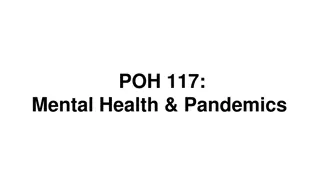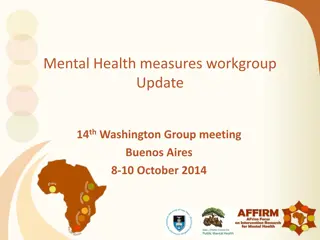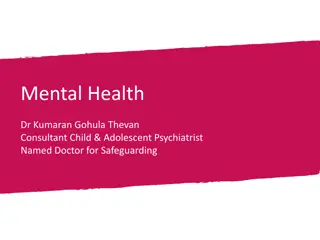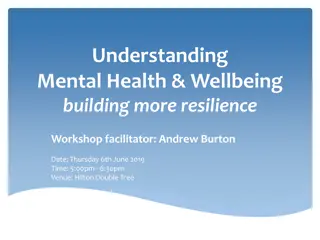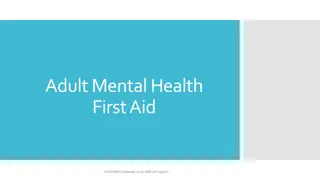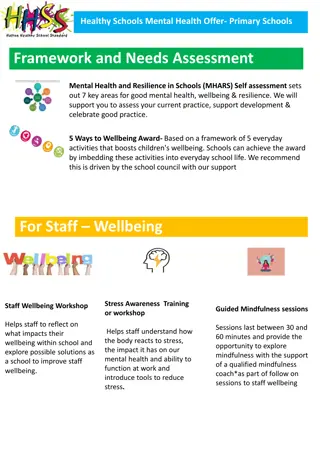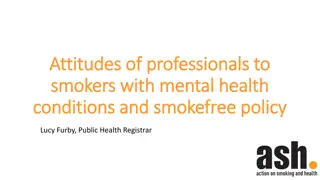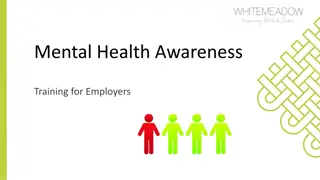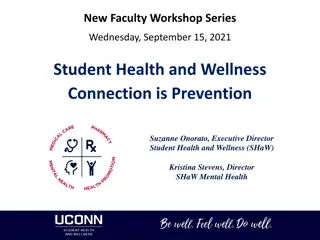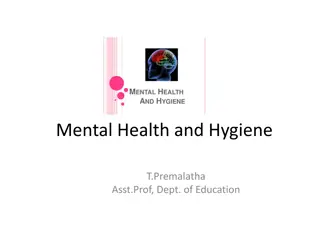Understanding Mental Health Challenges in Public Safety
Explore the unique behavioral health issues faced by public safety personnel, including firefighters and police officers. Learn about the specific statistics, department cultures, and necessary steps to support the mental well-being of those in these demanding professions.
Download Presentation

Please find below an Image/Link to download the presentation.
The content on the website is provided AS IS for your information and personal use only. It may not be sold, licensed, or shared on other websites without obtaining consent from the author. Download presentation by click this link. If you encounter any issues during the download, it is possible that the publisher has removed the file from their server.
E N D
Presentation Transcript
Mental Health Providers in Public Safety - What You Need to Know Kristen Herreid, MSW, AEMT City of Kenosha Mental Wellness Coordinator AEMT Twin Lakes Volunteer Fire Department
Objectives Identify common behavioral health issues experienced by members of public safety Explore the basics of the fire service profession, including day-to-day structure, call volume, & other unique aspects of the occupation Understand public safety culture and be able to describe unique features and how they differ from the general public Understand the use of peer support and its role in therapeutic treatment Discuss next steps clinicians can take to support the behavioral health needs of public safety personnel
Fire Specific Statistics Statistics from the 7000 IAFF members (in partnership with NBC) responded to a survey in 2017 80% believe asking for help is a sign of weakness 65% of FF have unwanted recurring memories 66% are easily angered/withdrawn 71% have sleep problems 26% have substance abuse 59% have relationship problems 19% have suicidal thoughts
Fire Department Culture Suck it up, Buttercup if you can t handle what you see, you are weak and can t do this job. It was expected to suppress their reactions Kitchen table Family oriented Mistrust - outside of the fire house and outside of the fire service Lack of unique identity Confidentiality (The Man Always Knows) Acceptance and encouragement of unhealthy coping Drinking, porn Divorce Sleep
Police Department Culture Extend little trust outside of the department Unique work hours/overtime Dark humor Acceptance and encouragement of unhealthy coping Drinking, porn Independent work
What You Need to Know Emphasis on rank, structure, order at work Department differences Professional vs. volunteers (fire) Shift work Long-standing careers Work family & immediate family Common personality traits & characteristics Mental health stigmas 81% fear they will be viewed as unfit/weak if they seek mental health treatment* 71% report having never used available EAP services*
Dont Call Them Heros Please don t call them heroes. They are not heroes, helpers, sinners or saints. They are first responders who may more appropriately be called primary responders or maybe just call them human. This group includes corrections officers, dispatchers, medical care workers, firefighters, paramedics, EMTs, police officers, airline personnel, and many more professions. The service of military at all ranks may not be classically viewed as responders but they must be included in this group. These people sometimes perform heroic acts, almost as a routine part of the job , as they say, although society tends to view them with a grander perspective. It is simply natural to recognize lifesaving or property saving behavior as the work of a hero. As the definition states, heroes demonstrate courage and perform outstanding achievements. Most do not want that recognition and will identify other people who are the true heroes. Identifying a hero is actually the purview of the recipient of their service. There is a problem with putting the title hero on the back of primary responders. That alone seems to satisfy the general public and the leaders who make important decisions. It is fashionable to recognize the heroes of the pandemic, for example. The support and recognition usually stop when the applause finishes. Maybe they want a pay raise, or better benefits, or better working conditions. Instead, they receive a round of applause. If they make a mistake on the job, especially a public error even one committed under immense stress, they are cast aside, migrating from hero to sinner. The unspoken need of primary responders is support. The stress of their work becomes overwhelming, oppressing their personnel lives and interrupting normal bodily function. Instead of applause, although that momentarily feels good, we should reach out softly and offer kind relief. By: Rick Barton, ICISF CEO
Exposure to Trauma On average, Americans will experience 3 traumatic experiences in their lifetime FF s experience 4 in one year (and often more, especially those on busy med units) Most will work a 20-year career it adds up quickly 800 in a career Research shows that 20-22% of fire fighters will meet criteria for PTSD during their career Types of trauma seen in the fire service: Line of duty death/FF/Police officer suicide Shootings Drowning Death of children Assault on FF, EMS or LEO Cardiac emergencies calling codes on scene
Exposure To Trauma Chronic, cumulative exposure 65% of firefighter respondents of online survey reported experiencing unwanted recurring memories* Substance misuse, isolation, unrealistic guilt, & shame are common Individuals with PTSD are 6 times more likely to attempt suicide
Common Behavioral Health Issues Chronic Stress Sleep dysregulation Interpersonal relationships Depression Anxiety Substance misuse/abuse Post-traumatic stress disorder Suicidality
Depression and Anxiety 7-11% of public service members experience clinical depression in a career* Depression is often covert Individuals with untreated depression are 20 times more likely to attempt suicide 70% of clients at COE meet criteria for Generalized Anxiety Disorder* Social Anxiety is also common Belief that treatment isn t earned is common *Source: COE data collected from October 2018-December 2019 through routine follow-up with alumni. This data was collected using a non-scientific survey one-month post discharge. N = 282 at admission, N = 208 at discharge; (Regehr, Hill, & Sault, 2003 p. 189-193); (Chiu, et al, 2010 p. 121 (3): 212-9); (Carey, et al, 2011 53(8): 929-933
Substance Use Alcohol 65% of clients upon admission to COE met criteria for hazardous drinking & alcohol dependence based on AUDIT score 27% of firefighter respondents of online survey reported using substances to cope with occupational stress & related emotional problems Opioids Stimulants & Benzodiazepines Caffeine *Source: (NBC IAFF National Summary Survey, 2018); COE data collected from October 2018-December 2019 through routine follow-up with alumni. This data was collected using a non-scientific survey one-month post-discharge. N = 282
Suicide Suicide is a concern numerous studies over the years and all showed similar statistics 46% of FF had suicidal ideation 19.2% have made suicidal plans 15.5% have made suicide attempts Important to address depression/co-occuring with PTSD need to stabilize the depression before focusing on trauma focused therapy
Suicide Risk Factors Demographic of the fire service Lack of effective coping skills Terminal uniqueness Public perception for police Substance misuse/abuse co-occurring mental health challenges Protective Factors Brotherhood & sisterhood Public perception for fire Increased awareness to behavioral health issues Sense of purpose & strong identity Action oriented
Mental Health What I see Reactivation of childhood trauma responding to emergencies can bring the first responder to confronting something that is similar to their own childhood trauma Reactivation of military trauma many come to this profession with military background Exposure is chronic and persistent Workaholism as coping strategy they take the idea of being busy to a whole new level. Most work overtime, have another job outside of the fire service, hold additional roles at work (union, HURT, TEMS, FIU, dive, health and safety) Emotional detachment is necessary to survive they can t allow themselves to get emotionally attached to the community members. It becomes very hard to turn this off, both with spouses and children (similar to the military) Lack of feeling supported by the department Injury (medical or mental) resulting in isolation from their support system Isolation from their support system when coping mechanisms fail and anxiety/depression take over Survivors guilt a sense of guilt that one survived while others did not; feeling one should have done more to prevent the loss
Unique Resources Peer Support Unique Resources Available Peer Support EAP IAFF IAFF Center of Excellence Rosecrance Florian Program IAPC
Tips for Effective Treatment Public services members posses a number of desirable client qualities. Emphasize & build on the innate problem-solving skills & task-oriented mindset. Trust, confidentiality, & cultural competency are keys to building rapport. Be prepared to hear graphic details of calls, dark humor, & strong language. The fire service is a clinically diverse population. Continuity and coordination of care are crucial. Members of the public service are high-functioning & resilient. Understand telling their story may take time and may never happen
Tips for Effective Treatment One size doesn t fit all Consider most debilitating symptoms Talking alone is rarely enough Must address behavioral avoidance EMDR and Brainspotting are effective techniques Don t forget the body yoga, breathing, meditation, mindfulness Use peer support when available
Next Steps Meet your local department & schedule a ride-a-long Connect with the peer support teams 77% report peer support was helpful* IAFF training to become an official team member Continued education & networking with like-minded treatment providers 62% of the fire fighters surveyed reported behavioral health services are inadequate*
Discussion/Questions Thank you! Kristen Herreid, MSW, AEMT kristen.herreid2019@gmail.com 262-949-4346










